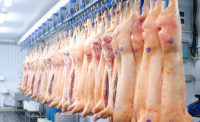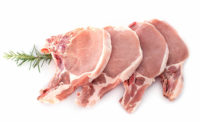Higher Education | Carcass Hanging Time
Microbials and the effect of extended hanging time on pork carcasses and blade steaks

The meat industry uses refrigeration as the air-chilling system to slow microbial growth and maintain carcass quality. In the pork industry, the time between harvest and fabrication is typically 24 to 48 hours. On the other hand, small pork processors may hold carcasses for an extended time prior to fabrication, and the effect of extended storage on the microbial quality of pork carcasses has not been well documented. To the best of our knowledge, supporting documentation is not available for holding pork carcasses an extended period. Thus, the objective of our study was to evaluate extended hanging time on the microbial quality of pork carcasses and vacuum packaged blade steaks fabricated from these carcasses during cold storage.
In this study, a total of 20 pigs was used, each weighing approximately 280-290 pounds. They were harvested on two separate days at the Kansas State University (KSU) Meats Laboratory (Manhattan, KS) under USDA inspection. All pigs were rendered unconscious using electrical stunning (400 volts for 15 s) and were immediately exsanguinated. Normal harvest procedures were used for processing. A zero-tolerance inspection was conducted to visually inspect for feces, milk, and ingesta on pork carcasses. Upon harvest completion, pork carcasses were sprayed with hot water (170°F to 200°F), and the right sides were weighed, labeled, and stored for up to 21 days in a carcass cooler that averaged 32°F with 87.3% relative humidity. Samples were taken from the jowl, shoulder and flank on storage days 1, 7, 14, and 21 and evaluated for aerobic plate count (APC), Enterobacteriaceae (EB), yeast and mold populations, surface pH, and moisture content.
On day 21 of the extended hanging time, pork carcasses were fabricated. Pork shoulder butts (Institutional Meat Purchase Specifications #406; USDA Agricultural Marketing Service, 2014) were removed, cut into six 1-inch–thick pork blade steaks, and then vacuum packaged and stored for an additional 35 days. These vacuum-packaged blade steaks were stored at 32°F and sampled on 0, 7, 14, 21, 28, and 35 days of storage for APC, EB, yeast and mold populations, and pH. All samples were excised using a sterile scalpel.
In the carcass cooler, the relative humidity ranged from 66% to 100%. To minimize shrinkage, it has been established that relative humidity should be between 85% and 90% (Sebranek, 2008). The pH of carcass surface was 5.84 to 5.88 on days 1, 7, and 14. On day 21, pH decreased to 5.72. This pH decrease was equivalent to 0.12 units. It is noteworthy to mention that this change may not have much effect on microbial growth. Out of the three anatomical locations sampled, the jowl had the greatest APC populations while the APC population from the flank and shoulder locations were not different. Overall, APC populations remained very low (0.84 to 0.99 log CFU/cm2) throughout the post-harvest extended hanging time.
Due to very low counts of EB and yeast and mold populations on the carcass, a detection limit (DL) was established. On pork carcass samples, the DL for EB and yeast and mold populations for the shoulder and flank and for the jowl samples was 0.06 and 0.41 log CFU/cm2, respectively. The jowl had the highest proportion of yeast populations above the DL compared to the flank and shoulder. The flank and shoulder had a similar proportion of yeast populations above the DL on days 1, 7, and 14 of storage; however, by day 21, the proportion of yeast proportions decreased.
The pH of pork blade steaks changed during storage time; however, the initial pH of 5.73 was similar to the pH of 5.69 at the end of the study. Pork blade steaks APC populations increased during storage time. On day 1, the APC population was 1.61 log CFU/g. This APC population reached 4.67 and 5.06 log CFU/g on days 28 and 35, respectively. Although an increase in APC populations was observed over time, bacterial growth did not exceed 8.0 log CFU/cm2, a level at which the development of off-odors and slime on meat occurs.
The DL for EB and for yeast and mold populations on pork shoulder blade steak samples was 0.70 log CFU/g. On days 0 and 7, all samples were below the DL for EB populations. On days 14 and 21, 4 and 7 samples were above the DL, respectively. By day 28, the number of EB populations on pork steaks was the highest with 16 samples above the DL. However, at day 35, samples above the DL for EB populations decreased to 10. All pork steaks samples were below the DL for mold populations on days 0, 7, and 14 of storage. On days 21, 28, and 35, 18, 24, and 12% of pork steak samples, respectively, were above the DL for mold populations. None of the samples exceeded 2.68 log CFU/g for mold populations.
In conclusion, the jowl had the highest APC population and the highest number of yeast populations above the DL. This may be the result of water flowing downward after spraying a pork carcass due to gravity and directed towards the jowl. Additionally, the carcass is commonly handled and moved using the jowl. Pork carcasses stored at 32°F and 87.3% relative humidity may be held for up to 21 days, and pork shoulder blade steaks fabricated from these carcasses and then vacuum packaged could be stored for 35 days without compromising microbial quality. IP
Looking for a reprint of this article?
From high-res PDFs to custom plaques, order your copy today!





